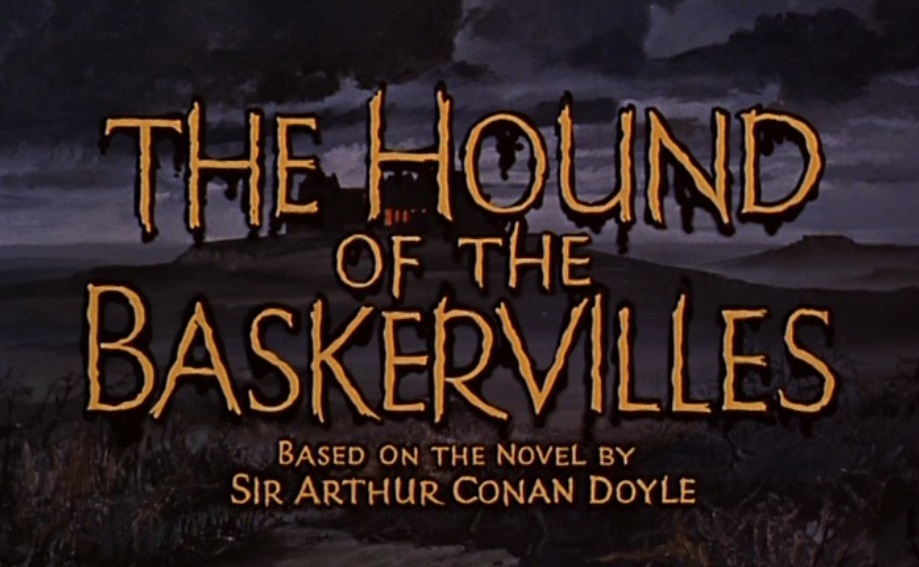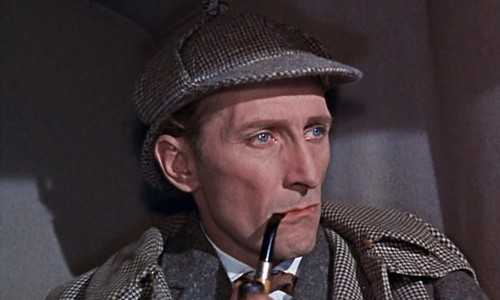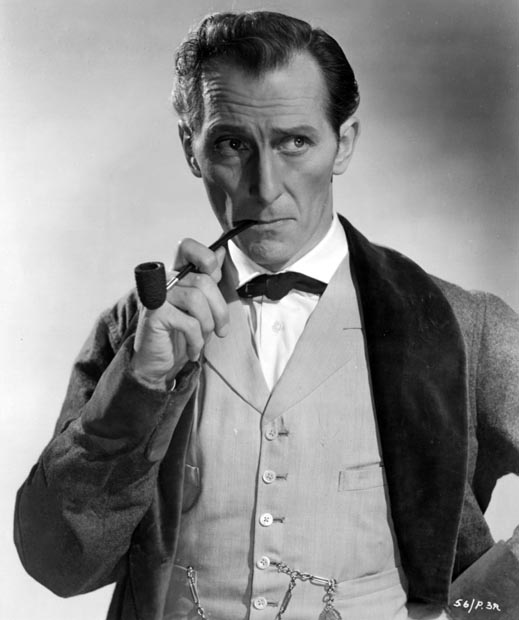THE HOUND OF THE BASKERVILLES (1959)
A review by Damian Michael Barcroft
“Sherlock Holmes’ Most Terrifying Adventure!”
I have always found it somewhat ironic that in his most famous case, Sherlock Holmes is largely absent from The Hound of the Baskervilles. However, despite the enduring popularity of the world’s greatest consulting detective, I would argue that the story owes much of its standing to the “horror” elements of the plot and that it is the Hound, rather than Holmes, that features as the main attraction for many readers or viewers. Indeed, if we assume this to be the case – albeit perhaps only temporarily – then we can easily deduce that after pillaging the most celebrated of Gothic narratives by Mary Shelley and Bram Stoker, then it was only logical for Hammer Films to choose Sir Arthur Conan Doyle’s most recognisable tale as their next literary horror adaptation.
As both a proud Sherlockian and an ardent admirer of Hammer, I find it difficult – though most compelling – to review the film with a professional objectivity that is impervious to exposing any perceivable bias for one or the other. Indeed, in order to prevent any further and unnecessary embarrassment, one may as well plead guilty immediately and admit to you, dear reader, that while the production has many strengths as another entertaining entry in the Hammer horror/thriller genre, it also has an abundance of weaknesses that prevent it from being a wholly successful adaptation of the story in equal measure and I fail to identify which of these factors are the most significant. Perhaps admitting defeat is hardly the best way to begin a review but I do hope you will find some small measure of amusement in reading this while I endeavour to unscramble the contradictory nature of the film, particularly the paradox of it being too horrific while at the same time not being scary enough.
While I shall resist the temptation of delivering this piece in the style of a defence and prosecution case, it would be remiss of me not to at least attempt to address both the positive and negative in a reasonably equilibrious manner. First and foremost, it must be said that the splendid Peter Cushing was an inspired piece of casting. While contemporary audiences and new enthusiasts of the character debate the merits of Benedict Cumberbatch and Robert Downey Jr, and the more seasoned connoisseurs may contemplate their devotion to either Basil Rathbone or Jeremy Brett, dear Mr Cushing remains both underrated in the role of Sherlock Holmes and as an actor in general. Case in point, and consider if you will, his extraordinary performance as Dr Van Helsing* in Dracula (1958), which I would argue is still the definitive screen interpretation of the part despite it also having been played by other such notable actors as Frank Finlay, Laurence Olivier and Anthony Hopkins. Further evidence of the great man’s work must surely include his depraved yet utterly charming and humorous characterisation of Baron Frankenstein which he played without repetition or fatigue six times between 1957-74, his utterly chilling performance as the fanatical witch-hunter, Gustav Weil who is even prepared to burn his own two nieces in Twins of Evil (1971), and the sheer star power and gravitas that he gave to the role of Grand Moff Tarkin in Star Wars (1977) to name but a few examples from an impressive and extensive filmography.
Perhaps more cynically, one could point out that since Cushing had previously appeared in four different Hammer productions (The Curse of Frankenstein, The Abominable Snowman [both 1957], Dracula and The Revenge of Frankenstein [both 1958]), it was hardly revelatory to cast him in the lead once again. However, Cushing was more than just a Hammer regular because in this particular role, as with many others, he suited the part perfectly, performed it with complete dedication and applied his devotion and considerable knowledge to the character. It was with a touch of sparkling serendipity then that he was cast to play Holmes as Cushing was an enthusiast and well versed in the work of Doyle, even owning an extensive collection of the original Strand magazines and he in fact based his appearance on the classic Sidney Paget illustrations from these. In addition to helping shape the look and costume of Holmes, Cushing was also instrumental in advising on the script and production design.
Cushing would later reprise the role of Holmes for other companies (see below) and it is fascinating to compare his performance in this production with the BBC series, Sir Arthur Conan Doyle’s Sherlock Holmes, in particular, the two-part adaptation of The Hound of the Baskervilles (1968). As Hammer’s Hound was the first to be presented in colour, so too was the BBC version first to be made for colour transmission and unfortunately that may be one of its few distinguishing features. Although the series received the highest television ratings of any Sherlock Holmes production, it suffered from a low budget and some very poor acting which contributed to the frequent lapses into the camp and melodramatic. This was a great shame as Cushing is extremely watchable and faithful to the character, so much so that it is a joy to see him pace up and down the rooms at 221b Baker and interact with the props and many nods to the canon. However Cushing found the intense shooting schedule traumatic and never committed to performing in a full television series again. Indeed, there are various signs of such discomfort and Cushing fumbles his words, even forgets his lines on several occasions and if one observes very closely, you can clearly see that his hands are often shaking.
In complete contrast however, the Hammer version boasts a confident, assured and perhaps even brave performance by Cushing as there seems to be no attempt whatsoever to make the characterisation of Holmes appealing or attractive. Indeed, this Holmes is positively disagreeable and waspish – arguably just as he should be. Countless actors had portrayed the character up to this point including William Gillette, Eille Norwood, John Barrymore, Clive Brook, Raymond Massey, Arthur Wontner, Robert Rendell, Reginald Owen, Basil Rathbone and Ronald Howard, but none of these seemed to go to such great lengths to repel their audience. Nevertheless, Cushing is utterly convincing and I would be so bold as to suggest that there are moments in this film when his performance scales the heights of other candidates for the definitive screen Holmes such as Rathbone and Brett.
The film also benefits from a strong performance from Andre Morell as Watson which was, at the time, a most superior and refreshing characterisation when so many other actors in the role still displayed echoes and reverberations of the buffoonish Nigel Bruce. Indeed, one could argue that it is Morell who actually carries the film since Holmes is missing for a large part of the middle section of the story. However, I must confess to being less than impressed with the rest of the supporting cast particularly the usually impressive and imposing Christopher Lee. While I acknowledge that the role of Sir Henry Baskerville is somewhat restrictive, I find his jodhpur-clad contribution rather disappointing and underwhelming to say the least. The love interest aspects of the story remain the least convincing and it is in these “romantic” scenes that Lee looks particularly uncomfortable. Indeed he performs the kissing of Cecile (Marla Landi) in a similar way and with as much relish as to how one would imagine Lee chewing a clove of garlic while playing Dracula. Of course Lee’s tall, dark and handsome (or gruesome as his autobiography is entitled!) features were arguably even more of a match than Cushing’s to the way in which Doyle described Holmes and I would highly recommend that you track down his performances as the character in the films listed below. Finally, on the subject of the actors, I must protest at the addition of Miles Malleson as Frankland, the bishop who is rather partial to the odd glass of sherry of three. I found him to be increasingly annoying and something of a distraction, so much so that the apparent comic relief was most unwelcome and unnecessary.
The crew were far more consistent in quality and indeed some of Hammer’s finest ingredients are present including director Terence Fisher, production designer Bernard Robinson, director of photography Jack Asher, composer James Bernard and make-up artist Roy Ashton. However, I can’t help but wish that the recently departed and hugely talented screenwriter Jimmy Sangster had written the screenplay instead of Peter Bryan and wonder if the film would have been better and much more polished a production had this been the case. As it is though, the script is reasonably faithful apart from some rather curious changes from the novel including Stapleton’s virtuous sister who is rewritten as manipulative and deleterious – not to mention half Spanish. Other issues that continue to irritate include the vexing question as to why on earth one of Stapleton’s hands are hideously webbed and why Sir Hugo ritualistically stabs the servant’s escaped daughter at the ruined abbey on an apparent sacrificial stone. Perhaps some of these instances are evidence of the pressure Bryan was no doubt under to heighten the horrific elements of the story. Uncharacteristically, I actually approve of some of the alterations to the book such as replacing a tarantula with the original merely threatening note which was more dramatic in theory if not entirely in execution! I also found the scene in which Holmes’ life is threatened in a disused mine to be welcome addition.
Inevitably though, and like many other adaptations of The Hound of the Baskervilles, the not so grand finale comes as something of a disappointment and anticlimax especially when the hound finally appears. This particular problem is intensified in a production that places so much of an (over)emphasis on horror and the poor dog is dressed up in a less than terrifying mask made of rubber and bits of rabbit. Perhaps on this occasion, Hammer could have created more suspense and fear if they had adopted the great Val Lewton’s approach and not shown the horror or creature at all as in Cat People (1942) and other such notable classics.
No study of the this film would be complete without mention and recognition of Hammer’s greatest director, Terence Fisher who guided some of the best productions for the studio including the aforementioned Dracula which for this particular reviewer remains a classic and one of British cinema’s finest films in the horror or any other genre. His direction for this film is as stylish and assured of any of his other pictures. James Bernard is also on form here and his music score is typically moody and atmospheric although it seems rather indolent to reprise his classic “chase” theme from Dracula during the sequence in which Sir Hugo pursues the servant girl across the moor. Finally, Bernard Robinson’s production design was once again very well executed, especially considering the small budget, including the impressively eerie swamp and abbey (Bray studios and location filming at Fensham Ponds in Surrey with some minor inserts of both Dartmoor and Holyport).
Despite its many qualities however, The Hound of the Baskervilles suffers from the inability to truly satisfy either the horror or Holmes enthusiast as there is a severe shortage of both. In other words there was not enough horror for those expecting another Frankenstein or Dracula, yet there was too much horror for those wanting to simply see Doyle’s book on the big screen. The novel was, and always will be, an adventure story with horrific elements and not a horror story with elements of adventure. Surely to sell and market a film on these terms is almost a misrepresentation of goods and the beauty of Hammer was that audiences usually knew exactly what to expect as depicted on the poster, trailer and more often than not, simply because it was another offering from that studio.
However, if we can somehow put aside our overzealous enthusiasm for either Hammer or Holmes, and we can accept it on its own terms, the film remains something of a minor classic and it is a great pity that Hammer’s proposed series of Sherlock Holmes films never materialised due to the poor box office returns of this production. Maybe this was not Sherlock Holmes’ most terrifying adventure as the tagline from the movie would have us believe and for those of you who are more accustomed to the speed and tightly edited pace of BBC’s Sherlock (2010), you may find this film to be a little insipid and perhaps even quaint. One could argue however, that there is much to be said, and indeed savoured in watching Sir Arthur Conan Doyle’s immortal character portrayed as he was originally written and also inhabiting the correct time period! @BakerStBabes, @Cumberbitches and other such assorted devotees to be found on twitter and elsewhere, please don’t… OUCH, too late!
* Peter Cushing also played Van Helsing in The Brides of Dracula (1960), Dracula AD 1972 (1972) and The Legend of the Seven Golden Vampires (1974) although it is generally agreed that it is only AD ’72 that is strictly a “Dracula” sequel. As the film was set in the seventies, Cushing played both the original Van Helsing in a period flashback sequence and also his own grandson while depicting contemporary London.
Further viewing and sleuthing available on DVD:
(Peter Cushing as Sherlock Holmes)
Sir Arthur Conan Doyle‘s Sherlock Holmes (1968, 16 x 50m TV adaptations*)
The Masks of Death (1984, TVM)
*Unfortunately only six of these episodes have actually survived.
(Christopher Lee as Sherlock Holmes)
Sherlock Holmes und das Halsband des Todes/Sherlock Holmes and the Deadly Necklace (1962)
Sherlock Holmes and the Leading Lady (1991, TVM)
Incident at Victoria Falls (1991, TVM)
Christopher Lee also played Sherlock Holmes’ brother Mycroft in the 1970 pastiche, The Private Life of Sherlock Holmes.
This article was originally written for http://www.britmovie.co.uk/ in December 2011




